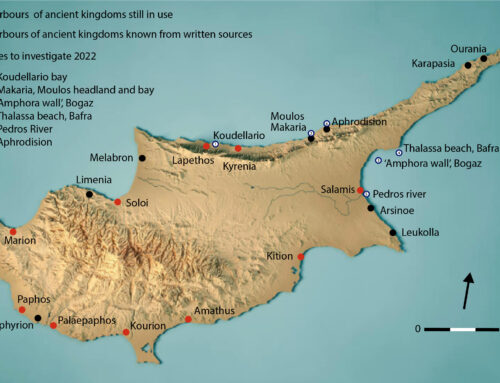Further Investigation of Marine Archaeology Heritage at Akanthou – 2020-2021
Dr Muge Sevketoglu
Investigation of archaeological sites on the North Cypriot coast through rescue excavation exemplified use of maritime resources. Bays formed in the limestone bedrock and sea currents create favourable conditions at Akanthou for harbourage, explaining the consistent settlement and exploitation of this coastline for at least 10,000 years. Various threats from development, erosion, fishing, and recreational diving are impacting this environment. The project implements protection of maritime heritage through survey and legal designation, while developing capacity building of young archaeologists to undertake underwater assessment. Under the management of the Centre for Archaeology, Cultural Heritage and Conservation, the project continued research funded by HFF in 2018, surveying the bays around Akanthou (find out more here).
The project was delayed by pandemic restrictions, but adapted to undertake successful survey. Several bays around Akanthou were surveyed, demonstrating the unbroken connection between the coastal settlement, shore and underwater archaeological record. Underwater visual search photographed and mapped artefacts. Land survey consisted of field walking with finds recorded by mapped field boundaries to allow legal protection designation from ministry records. There was no removal of artefacts with one exception, the lifting of an anchor (engraved with hieroglyphs) after a decision made by the Antiquities Department and Higher Monuments Council, who considered there was a risk of loss or damage. The survey methods employed fulfilled the evidential requirements to schedule and protect maritime archaeology under law.
Consistent evidence of maritime and coastal heritage was found across the surveyed area. Stone anchors, weights and clusters of amphorae and other ceramics were found inside harbours. Beyond one harbour mouth a wreck was located, with numerous clustered intact amphorae at the location and distributed immediately to the North. The wreck appears Late Roman in date. The terraces, slopes and shorelines of the bays revealed widespread Neolithic tools and evidence of settlement as well as later Byzantine periods rock-cut tombs. A day was spent raising the anchor carved with hieroglyphics to ensure it was protected. The anchor was taken to the Department of Antiquities conservation lab for treatment and 3-D scanning. It appears to be part of a stelae re-used as an anchor. The scans are being studied to help determine origin.
The results develop a model process for wider survey and protection on the North Cyprus coast. Future research will refine the process further.
Artefact analysis will determine dating evidence and the relative importance of finds in Cypriot and Mediterranean maritime heritage, assisting in strengthening site protections. It is hoped significant finds and results can be published through Honor Frost Foundation publications, and through museum displays, highlighting the need for protection and preservation.






Previous
Next


